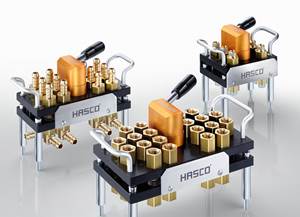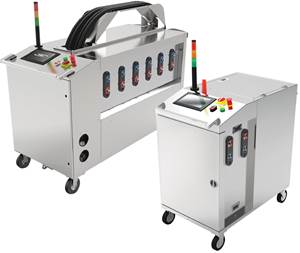Six Things You Should Know About New Eco-Friendly Chillers
If you never paid much attention to what kind of refrigerant is circulating inside your plastics chillers, it may be time you did.
If you never paid much attention to what kind of refrigerant is circulating inside your plastics chillers, it may be time you did. New regulations took effect on Jan. 1, which limit the types of refrigerants that can be used in new chillers and reduce worldwide production of the old R22 refrigerant you have been using. Chiller suppliers are now talking about a welter of replacement refrigerants with designations like R410a, R407c, R134a, R404a, and R507. What does all this mean for you?
1. IT’S THE LAW
What’s happening is not a conspiracy of chiller suppliers to make you buy new equipment. It all goes back to an international agreement called the Montreal Protocol for protection of the atmospheric ozone layer, signed by the U.S. in 1987 and enforced by the Clean Air Act of 1990. Since then, there has been a global phase-out of the most ozone-damaging refrigerants, solvents, and foam blowing agents—first R12 in the 1980s and now R22, which has been the standard in plastics chillers. Under U.S. law, no new chillers could be built to use R22 after Jan. 1, 2010.
2. YOU CAN KEEP YOUR OLD CHILLERS
It is not illegal to continue to use chillers that contain R22. In fact, for a little while longer, you may be able to buy chillers built before Jan. 1 that contain R22. As of last month, a few suppliers still had some of these units in stock. For some years to come, you will be able to get additional R22 to service your existing chillers. However, supplies will steadily decrease, and the cost is expected to rise accordingly. January 1 saw a 60% drop in the global cap on R22 production mandated by the Montreal Protocol, and prices simultaneously jumped more than 20% higher. The global production cap will drop another 60% in 2015, and all R22 production is scheduled to cease in 2020. After that, R22 will be available only from recovered and recycled stock.
3. THERE ARE NUMEROUS ALTERNATIVES
Three alternative refrigerants are most commonly used in plastics chillers—R407c, R410a, and R134a. They are readily available and are not really new technology, as they have been used in automotive and home air conditioning for a number of years. R407c is found in many European-built chillers, since the European Union phased out R22 years ago. A number of domestic suppliers have been using R134a in the very smallest chillers for years. Some of the major U.S. suppliers began introducing models with R410a or R407c more than a year ago. They report that there have been no issues with these units in field.
4. DOES IT MATTER WHICH ONE I USE?
Probably not very much. And in some cases, there isn’t much choice anyway, because technical reasons limit the range of applicable refrigerants. As shown in the table opposite, most suppliers offer a range of refrigerants, often segmenting them by application (temperature range), compressor type, or equipment size. For example, some suppliers say only R134a is compatible with central chillers based on oilless, centrifugal compressors—which are sold by Thermal Care and Frigel.
A number of suppliers—including Advantage Engineering, AEC, Conair, Delta T, and Mokon—agree that R134a is preferable for very small units. The reason is that it is the only commonly available refrigerant that operates at a pressure lower than that for R22; all the others operate at higher pressures. Lower pressures mean that lower-horsepower compressors can be used, which reduces operating costs. Lower pressure and compressor horsepower with R134a are also the reasons why some suppliers favor it for the largest central chillers as well. Components for building very large chillers with the highest-pressure refrigerant, R410a, are not yet readily available. R410a operates at 340 to 390 psi or higher, vs. 215 to 245 psi for R22.
Two less commonly mentioned refrigerants are used for especially low-temperature chillers—R507 or R404a for temperatures below 20 F and down to -40 F.
Although European equipment makers tend to rely largely on R407c, the chart shows that major domestic suppliers are leaning toward R410a. Even some, like Mokon and Frigel, that are focusing initially on R407c, believe that R410a could be “the wave of the future” when a wider range of high-pressure components become available and component prices ease with higher volumes.
Advocates of R410a—such as AEC, Conair, and Thermal Care—point out that it’s the most efficient refrigerant. That means that users may experience energy savings (kw/ton) of anywhere from 2% to 5%. Sources at Advantage Engineering and Conair are not so sure, pointing out that slightly greater compressor efficiency is only one factor in the overall efficiency of a chiller system. Advocates also note that the efficiency of R410a allows use of smaller internal components and piping, which could enable a slightly more compact chiller design. Advantage sources again believe that overall chiller design is a bigger influence on footprint than slight differences in component sizes.
Another point of comparison between R407c and R410a is cost. Chiller makers agree that the cost of components for chillers with R407c is about the same as for R22, but building a chiller for R410a currently costs an average of 5% to 10% (and sometimes up to 15%) more, though costs may come down in the future. Some chiller suppliers, however, say they have not raised prices on chillers with R410a.
Overall, it is difficult to compare efficiency, compactness, and cost of new vs. old chillers strictly on the basis of refrigerants. One reason is that in redesigning their equipment for new refrigerants, suppliers have simultaneously implemented a number of upgrades in compressors, condensers, and controls.
One other point of debate concerning refrigerants is maintenance issues. Some sources note that industrial refrigeration service firms (as opposed to home refrigeration specialists) may be less familiar and comfortable with R410a and the higher pressures involved. R407c is more similar in pressure to R22, so more service firms may be equipped to handle it, at least initially. On the other side of the coin, it is sometimes pointed out that R407c is a mixture of three gases, while R410a is a more compatible mix of two gases. One may encounter arguments that if a chiller with R407c leaks some refrigerant, the lighter components escape first, thereby changing the composition of the remaining mix and its refrigeration performance. That allegedly means the leaking chiller could not simply be “topped up” with more R407c—instead, the whole refrigerant charge would have to be removed and replaced, at higher cost. Because of the more compatible mix of ingredients, R410a reportedly is not susceptible to these issues. But be aware that some chiller suppliers dismiss this as just “marketing talk,” even while sometimes admitting they have used that argument themselves. They say tests and field experience show there is no practical difference between R407c and R410a in ease or cost of chiller maintenance.
All these various issues, whether or not of practical importance, appear to have motivated firms such as AEC, Advantage, and Thermal Care to offer both R407c and R410a for their most popular chillers, though they are encouraging customers to choose R410a.
5. DO I NEED A WHOLE NEW CHILLER?
As noted above, the higher operating pressures of most of the R22 replacements necessitate substitution of beefier compressors, piping, seals, etc. What’s more, the alternative refrigerants are not compatible with the mineral-type compressor oils used with R22 and require synthetic oils instead. While it is theoretically possible to replace the oil, compressor, and other components—especially if the switch is to R407c—it may or may not be cost-effective to do so. That would depend on the size and “technological age” of the chiller. Mokon sources said it could be cost-effective to switch a smaller chiller to R407c. However, no supplier interviewed has received any requests to retrofit a unit for the new refrigerants.
6. IT’S NOT THE END OF THE STORY
Chiller suppliers doubt that the switch from R22 to the current stable of refrigerants will be the end of the story. Several others are being actively considered, and something new could pop up. In Europe, there is even interest in propane or butane for very small chillers up to 1 ton.
One looming factor in refrigerant choices is “global warming potential,” or GWP. This is another atmospheric impact of refrigerants besides their ozone-depletion potential (ODP), and some chiller suppliers think it could become the next front for U.S. environmental regulators. GWP is already said to be the primary driver in European refrigerant regulation. R22 and most of the current substitutes have GWPs within a fairly similar range.
Related Content
Free Cooling Chiller System Launches
Delta T Systems enters the free cooling space with a line that uses ambient air to cool the process fluid.
Read MoreMulticoupling Range Extended
Hasco‘s quick-connect system for multiple cooling circuits has added U.S., French and HT versions.
Read MoreConair Names New Head of Customer Care
Jared Helfrich to direct the efforts of the machine builder’s growing customer care group, combining its existing parts and service and repair organization with a new range of fast-growing customer services.
Read MoreSystem Offers 'Lights Out' Mold-Channel Cleaning & Diagnostics
New system automatically cleans mold-cooling lines—including conformal channels—removing rust and calcium, among other deposits, while simultaneously testing for leaks, measuring flow rate and applying rust inhibitor.
Read MoreRead Next
For PLASTICS' CEO Seaholm, NPE to Shine Light on Sustainability Successes
With advocacy, communication and sustainability as three main pillars, Seaholm leads a trade association to NPE that ‘is more active today than we have ever been.’
Read MoreBeyond Prototypes: 8 Ways the Plastics Industry Is Using 3D Printing
Plastics processors are finding applications for 3D printing around the plant and across the supply chain. Here are 8 examples to look for at NPE2024.
Read MoreMaking the Circular Economy a Reality
Driven by brand owner demands and new worldwide legislation, the entire supply chain is working toward the shift to circularity, with some evidence the circular economy has already begun.
Read More















